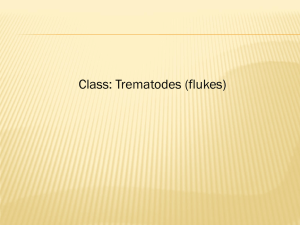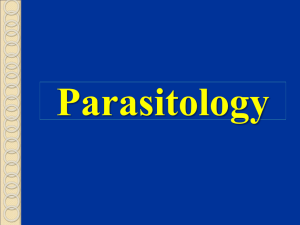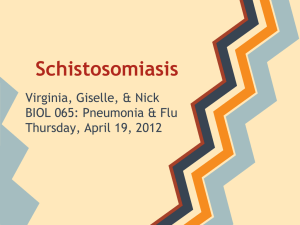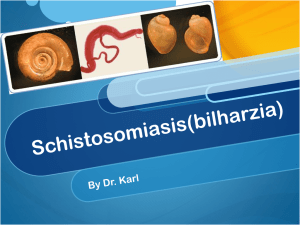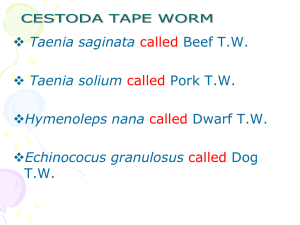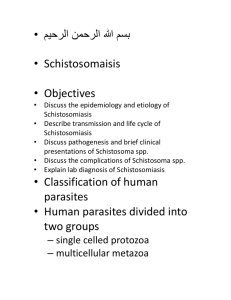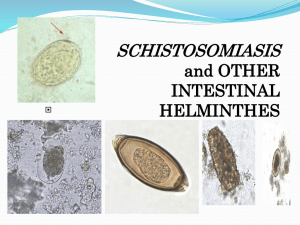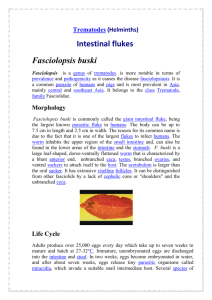محاضره 7
advertisement
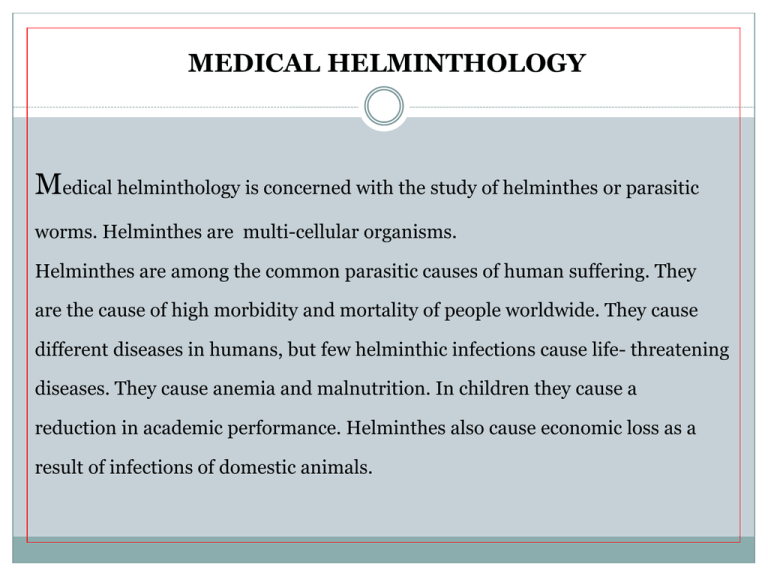
MEDICAL HELMINTHOLOGY Medical helminthology is concerned with the study of helminthes or parasitic worms. Helminthes are multi-cellular organisms. Helminthes are among the common parasitic causes of human suffering. They are the cause of high morbidity and mortality of people worldwide. They cause different diseases in humans, but few helminthic infections cause life- threatening diseases. They cause anemia and malnutrition. In children they cause a reduction in academic performance. Helminthes also cause economic loss as a result of infections of domestic animals. The sources of the parasites are different. Exposure of humans to the parasites may occur in one of the following ways: 1. Contaminated soil (Geo-helminthes), water (cercariae of blood flukes) and food (Taenia in raw meat). 2. Blood sucking insects or arthropods (as in filarial worms). 3. Domestic or wild animals harboring the parasite (as in echinococcus in dogs). 4. Person to person (as in Enterobius vermicularis, Hymenolopis nana). 5. Oneself (auto-infection) as in Enterobius vermicularis. The helminthes are classified into three major groups. These are: 1. Trematodes (Flukes) 2. Nematodes (Round worms) 3. Cestodes (Tape worms) The Trematodes and Cestodes are groups of flat worms. TABLE: DIFFERENTIATING FEATURES OF HELMINTHES CESTODE TREMATODE NEMATODE Shape Tape like, segmented Leaf like, Unsegmented Elongated, Sexes Not separate Not separate Cylindrical (monoecious) (monoecious) Separate. (diecious) Except Schistosoma "Head" End Suckers: with hooks Suckers: no hooks No suckers, and hooks Alimentary canal Absent Present but incomplete Present and complete Body cavity Absent Absent Present MEDICALLY IMPORTANT TREMATODES (FLUKES) Trematodes belong to the phylum platyhelminthes. They are found in a wide range of habitats. The great majority inhabit the alimentary canal, liver, bile duct, ureter and bladder of vertebrate animals. According to the sites they inhabit, there are four groups of flukes. These are: Blood flukes, Intestinal flukes, Liver flukes, and Lung flukes BLOOD FLUKES SCHISTOSOMIASIS (BILHARZIASIS) It is estimated that about 600 million people in 79 countries suffer from schistosomiasis (Bilharziasis). The schistosomes cause intestinal, hepatosplenic, pulmonary, urogenital, cerebral and other forms of schistosomiasis. Schistosome is the only fluke with separate sexes. The female worm lies in the gynecophoral canal of the male. This condition is important for transportation. There are five medically important species: 1. Schistosoma mansoni: causes intestinal schistosomiasis. 2. Schistosoma haematobium: causes vesical (urinary) schistosomiasis. 3. Schistosoma japonicum: causes intestinal schistosomiasis. 4. Schistosoma intercalatum: causes intestinal schistosomiasis. 5. Schistosoma mekongi: causes intestinal schistosomiasis. This seems to cause milder disease in man. It causes disease in other vertebrate hosts. SCHISTOSOMA MANSONI Habitat: This species lives in the veins of the intestine. Geographical distribution: It is found in Africa, South America, Middle East (some Arab countries) etc. The snail hosts that harbor S. mansoni are the genera: Biomphalaria (B. glabrata) and Trobicorbis. These have oval shells. Morphology: Male: The male ranges in size from 1-1.4 cm in length and the body is covered by coarse tubercles. Female: The female is 1.5-2.0 cm in length. . It lays about 100-300 eggs daily. URINARY SCISTOSOMIASIS Etiology - Schistosoma haematobium Habitat - The worm lives in the veins of the bladder of humans. The peak prevalence is the 10-14 year age group. The snail hosts that harbor S. haematobium are the genera Bullins (Bullins africanus, B. truncates) Male: The male ranges in size from 1-1.5 cm in length. The body is covered by fine tubercles. Female: The female ranges in size from 2-2.5 cm in length. The ovary is present. It lays about 20-200 eggs daily. Distribution: Distribution: In Ethiopia, in the west in low SCHISTOSOMA JAPONICUM The female adult worm lays about 500-3500 eggs daily. The eggs are ovoid, bearing only a minute lateral spine or a small knob postero-laterally. It is found in Japan, China, and Philippines, etc. LIFE CYCLE OF SCHISTOSOMES Adult worms reside in pairs: the female lying in the gynecophoral canal of the male. After fertilization, eggs are passed into the venules. A larval form – the miracidium - develops within the egg. The eggs pass into the lumens and organs and are evacuated in the feces (S. mansoni) or the urine (S. haematobium). On contact with fresh water the miracidia hatch from the eggs and swim about until they find the appropriate snail, which they penetrate. After two generations of sporocyst development and multiplication within the snail, the fork-tailed cercariae emerge. Infection to man takes place during bathing or swimming. The cercariae penetrate the skin, are carried into the systemic circulation and pass through to the portal vessels. Within the intrahepatic portion of the portal system, the worms feed and grow to maturity. Symptoms and complications Patients infected with S. haematobium suffer from terminal hematuria and painful micturition. There is inflammation of the urinary bladder (cystitis), and enlargement of spleen and liver. Patients infected with S. mansoni suffer from cercarial dermatitis (swimmers itch) and dysentery (mucus and blood in stool with tenesmus) as well as enlargements of the spleen and liver. S. haematobium causes squamous cell carcinoma in the bladder. Laboratory Diagnosis S. mansoni Microscopic examination of the stool for eggs after concentration by sedimentation method. The egg has characteristic lateral spine. Rectal snip S. haematobium: Examination of the urine after allowing it to sediment in a conical urinalysis glass. A drop from the sediment is taken and examined for eggs. Egg has terminal spine. Biopsy from bladder Treatment: Praziquantel: single oral dose of 40 mg/kg divided into two doses. Prevention: 1. Health education: A. On use of clean latrines and safe water supply B. Avoid urination and defecation in canals, avoid contact with canal water 2. Snail control: A. Physical methods: i. Periodic clearance of canals from vegetation's. ii. Manual removal of snails and their destruction. B. Biological methods: Use of natural enemies to the snails such as Marisa. C. Chemical methods: Molluscides are applied in the canals to kill the snails. INTESTINAL FLUKES ♦ Fasciolopsis buski: These giant intestinal flukes (2-7.5 cm in length) are found in some Asian countries. ♦ Heterophyids (Heterophyes heterophyes): Minute flukes acquired by ingestion of raw fresh water fish. They are found in Asian countries. LIVER FLUKES Clonorchis sinensis: Chinese liver fluke- adult worms live in bile ducts. Faciola hepatica: Sheep liver fluke-is a common parasite, cosmopolitan in distribution. It is large (3 cm in length). Adult worms reside in the large biliary passages and gall bladder. Faciola gigantica: lives in the liver of cattle. Human infections are very rare.
